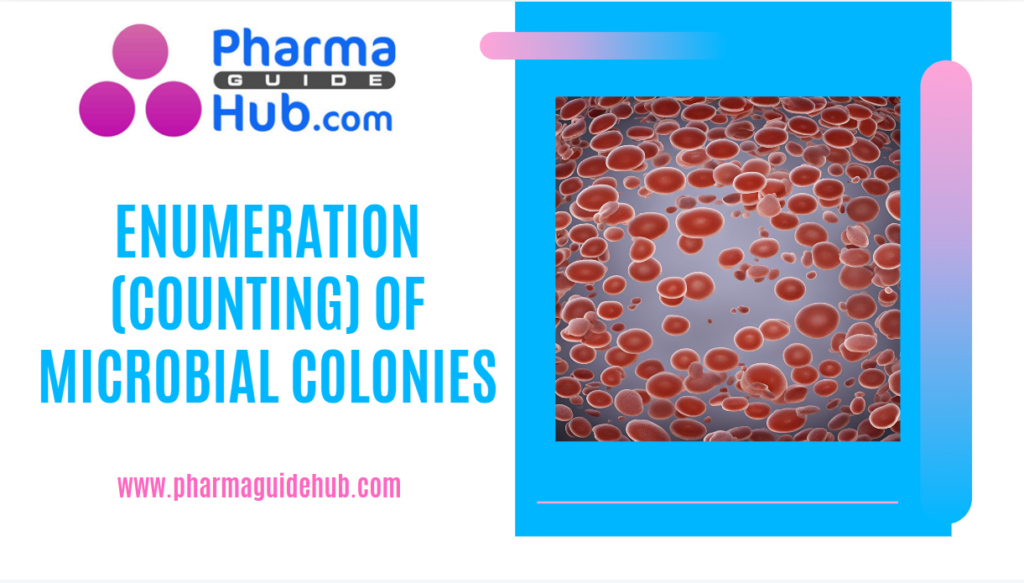
- OBJECTIVE:
To lay down a procedure for enumeration of Microbial Colonies.
- SCOPE:
This SOP deals with enumeration of Microbial colonies in environmental monitoring plates, water analysis plates, growth promotion test results and other microbial tests by using the colony counter.
- RESPONSIBILITY:
- Microbiologist- Observer & Reviewer shall be responsible for Operation of the colony counters as per the SOP. To arrange all the incubated media plates that needs to be enumerated. Enumeration of plates under observation. To inform the In charge- Microbiology, if any excursions, particles and other discrepancies. Recording results.
- In charge-Microbiology/ Head-Quality Control: shall be responsible to ensure the compliance of SOP. To approve the results of enumeration. To enumerate the suspected colonies based on the Microbiologists feedback. To initiate the investigation if any excursions or discrepancies.
- ACCOUNTABILITY:
QA Head shall be accountable for implementation of SOP.
- PROCEDURE:
Enumeration of microbial colonies is a crucial technique in microbiology that involves counting the number of visible bacterial or fungal colonies on a growth medium. These colonies represent individual microorganisms that have multiplied and formed a visible clump. By accurately counting these colonies, scientists can estimate the concentration of viable microorganisms in a sample.
Ensure to switch on the audio button, which gives a beep sound for each press while counting the colonies.
Operate the colony counter as per the respective equipment SOP.
Arrange the incubated plates near the colony counting area in a segregated, staggered, orderly manner as per the sampling type and sampling areas as applicable to ensure that no plates are missed during the observations e.g. settle plates of grade-A, settle plates of grade-B and settle plates of Grade-C.
Click the link for download word file copy of this document: https://pharmaguidehub.com/product/enumeration-counting-of-microbial-colonies/
Place the petri plate on the glass base for counting the colonies.
The light transfers from the bottom of the plate and reaches the agar surface so that colonies can be viewed clearly through magnifying lens (Ensure to adjust the magnifying lens in suitable height to view clear magnified image).
Observe the plates on both sides (Bottom and Top) and edges of the petri dish for colonies.Count the colonies by pressing the tip of the marker over the colonies (back side of the petri dish) and the digital display will show the total number of colonies present in a plate.
After observing in colony counter, again verify the plates visually.
If any colonies are observed under visual inspection, count the same by pressing the tip of the marker over the colonies (back side of the petri dish).
If required, open the lid of the plate for few seconds to confirm no minute colonies are missed during observations, or in case of any condensation on the lid.
Ensure that all the colonies of the plate under observation are counted by the colony counter before recording the results in the respective format.
Ensure that each observed plate shall be placed separately to avoid mix-up with unobserved plates.
During the reading of microbiological plates, five minutes break shall be taken after every one hour of reading the plates.
Reset the button on colony counter before counting the next plate.
In the case of Grade-A and Grade-B environmental monitoring plates, after completion of the enumeration by Observer (First Microbiologist), the same plates shall be reviewed by reviewer (second Microbiologist).
In the case of water plates (with membrane), enumeration shall be performed from the top of the plate.
Observer and reviewer shall record the usage details in the equipment usage log.
Note: Review by two Microbiologists is a practice limited to aseptic operations in case of environmental monitoring plates.
In case no growth observed in SCDM after incubation, suspected particles shall be confirmed as a non viable particle and document accordingly.
If any abnormalities/ discrepancies observed during the enumeration, the same shall be brought to the notice to in charge-Microbiology for further action or investigation as required.
In case of any excursion, the same shall be brought to the notice of In charge-Microbiology to initiate the PNC following investigation.
In case, discrepancy in results between observer and reviewer, the same shall be brought to the notice of In charge-Microbiology to initiate the PNC and re-training.
In case, particles are suspected during the enumeration, the same shall be intimated to In charge Microbiology.
In charge-Microbiology shall review the same and further investigation shall be decided.
Inoculate the suspected particle into Soya bean casein digest medium (SCDM) and incubate for 3-5 days at 30-35°C and record the results in Format No-1.
If growth observed in SCDM after incubation, same shall be considered as a viable colony and document accordingly.
Where applicable, Stereo or compound microscope can also be used, in case of suspected particles for further processing and investigation.
Note: Hold the observation till completion of investigation. After conclusion, document the results accordingly.
Switch OFF the power of colony counter after completion of counting.
If required, photographs of the same shall be archived.
Click the link for download word file copy of this document: https://pharmaguidehub.com/product/enumeration-counting-of-microbial-colonies/
REFERENCES:
Not Applicable
ANNEXURES:
| Annexure Number | Title of annexure |
| Annexure-I | Identification of suspected particles in the environmental monitoring plates |
DISTRIBUTION:
Master Copy : Quality Assurance Department
Controlled Copy No. 01 : Head Quality Assurance
Controlled Copy No. 02 : Head QC (Micro)
ABBREVIATIONS:
| No. | : | Number |
| SOP | : | Standard Operating Procedure |
| EM | : | Environment Monitoring |
REVISION HISTORY:
CHANGE HISTORY LOG
| Revision No. | Details of Changes | Reason for Change | Effective Date |
| 00 | New SOP | Not Applicable | To Be Written Manual |
Flow Chart

Annexure-I
IDENTIFICATION OF SUSPECTED PARTICLES IN THE ENVIRONMENTAL MONITORING PLATES

Click the link for download word file copy of this document: https://pharmaguidehub.com/product/enumeration-counting-of-microbial-colonies/
